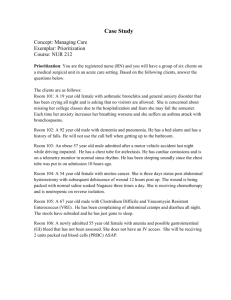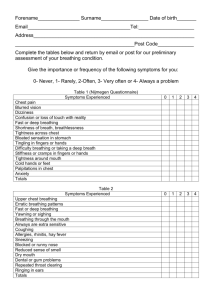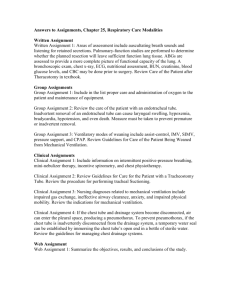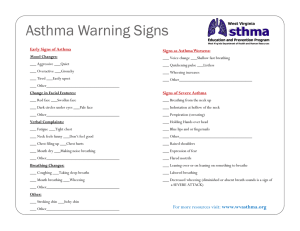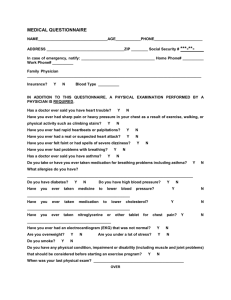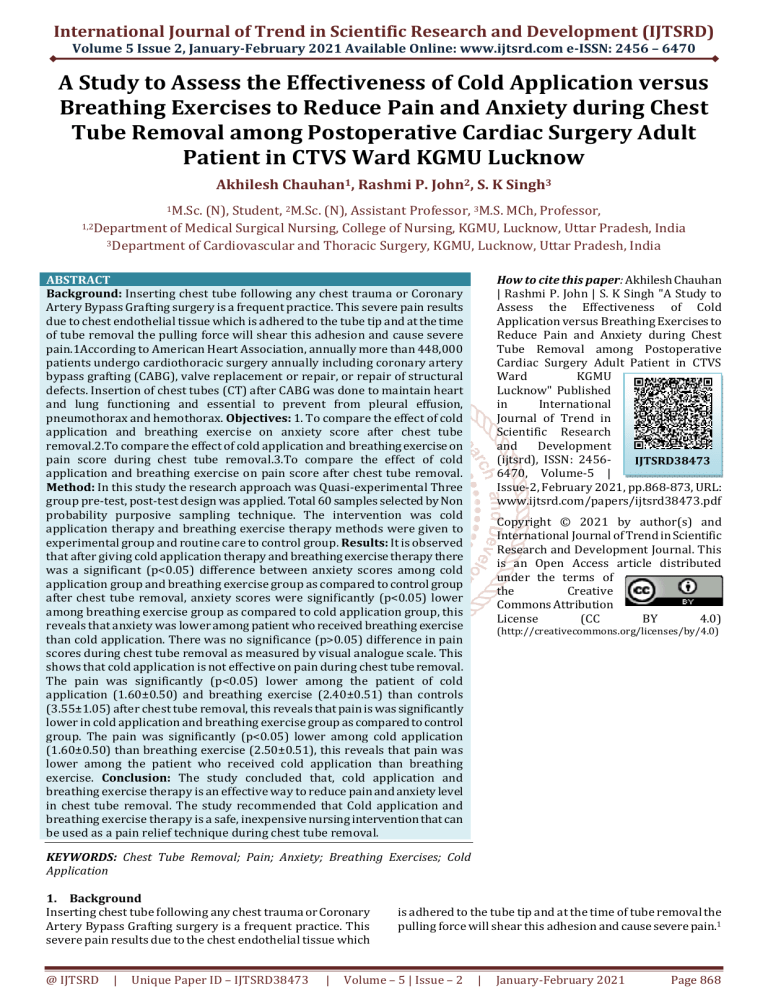
International Journal of Trend in Scientific Research and Development (IJTSRD)
Volume 5 Issue 2, January-February 2021 Available Online: www.ijtsrd.com e-ISSN: 2456 – 6470
A Study to Assess the Effectiveness of Cold Application versus
Breathing Exercises to Reduce Pain and Anxiety during Chest
Tube Removal among Postoperative Cardiac Surgery Adult
Patient in CTVS Ward KGMU Lucknow
Akhilesh Chauhan1, Rashmi P. John2, S. K Singh3
1M.Sc.
(N), Student, 2M.Sc. (N), Assistant Professor, 3M.S. MCh, Professor,
1,2Department of Medical Surgical Nursing, College of Nursing, KGMU, Lucknow, Uttar Pradesh, India
3Department of Cardiovascular and Thoracic Surgery, KGMU, Lucknow, Uttar Pradesh, India
ABSTRACT
Background: Inserting chest tube following any chest trauma or Coronary
Artery Bypass Grafting surgery is a frequent practice. This severe pain results
due to chest endothelial tissue which is adhered to the tube tip and at the time
of tube removal the pulling force will shear this adhesion and cause severe
pain.1According to American Heart Association, annually more than 448,000
patients undergo cardiothoracic surgery annually including coronary artery
bypass grafting (CABG), valve replacement or repair, or repair of structural
defects. Insertion of chest tubes (CT) after CABG was done to maintain heart
and lung functioning and essential to prevent from pleural effusion,
pneumothorax and hemothorax. Objectives: 1. To compare the effect of cold
application and breathing exercise on anxiety score after chest tube
removal.2.To compare the effect of cold application and breathing exercise on
pain score during chest tube removal.3.To compare the effect of cold
application and breathing exercise on pain score after chest tube removal.
Method: In this study the research approach was Quasi-experimental Three
group pre-test, post-test design was applied. Total 60 samples selected by Non
probability purposive sampling technique. The intervention was cold
application therapy and breathing exercise therapy methods were given to
experimental group and routine care to control group. Results: It is observed
that after giving cold application therapy and breathing exercise therapy there
was a significant (p<0.05) difference between anxiety scores among cold
application group and breathing exercise group as compared to control group
after chest tube removal, anxiety scores were significantly (p<0.05) lower
among breathing exercise group as compared to cold application group, this
reveals that anxiety was lower among patient who received breathing exercise
than cold application. There was no significance (p>0.05) difference in pain
scores during chest tube removal as measured by visual analogue scale. This
shows that cold application is not effective on pain during chest tube removal.
The pain was significantly (p<0.05) lower among the patient of cold
application (1.60±0.50) and breathing exercise (2.40±0.51) than controls
(3.55±1.05) after chest tube removal, this reveals that pain is was significantly
lower in cold application and breathing exercise group as compared to control
group. The pain was significantly (p<0.05) lower among cold application
(1.60±0.50) than breathing exercise (2.50±0.51), this reveals that pain was
lower among the patient who received cold application than breathing
exercise. Conclusion: The study concluded that, cold application and
breathing exercise therapy is an effective way to reduce pain and anxiety level
in chest tube removal. The study recommended that Cold application and
breathing exercise therapy is a safe, inexpensive nursing intervention that can
be used as a pain relief technique during chest tube removal.
How to cite this paper: Akhilesh Chauhan
| Rashmi P. John | S. K Singh "A Study to
Assess the Effectiveness of Cold
Application versus Breathing Exercises to
Reduce Pain and Anxiety during Chest
Tube Removal among Postoperative
Cardiac Surgery Adult Patient in CTVS
Ward
KGMU
Lucknow" Published
in
International
Journal of Trend in
Scientific Research
and
Development
(ijtsrd), ISSN: 2456IJTSRD38473
6470, Volume-5 |
Issue-2, February 2021, pp.868-873, URL:
www.ijtsrd.com/papers/ijtsrd38473.pdf
Copyright © 2021 by author(s) and
International Journal of Trend in Scientific
Research and Development Journal. This
is an Open Access article distributed
under the terms of
the
Creative
Commons Attribution
License
(CC
BY
4.0)
(http://creativecommons.org/licenses/by/4.0)
KEYWORDS: Chest Tube Removal; Pain; Anxiety; Breathing Exercises; Cold
Application
1. Background
Inserting chest tube following any chest trauma or Coronary
Artery Bypass Grafting surgery is a frequent practice. This
severe pain results due to the chest endothelial tissue which
@ IJTSRD
|
Unique Paper ID – IJTSRD38473
|
is adhered to the tube tip and at the time of tube removal the
pulling force will shear this adhesion and cause severe pain.1
Volume – 5 | Issue – 2
|
January-February 2021
Page 868
International Journal of Trend in Scientific Research and Development (IJTSRD) @ www.ijtsrd.com eISSN: 2456-6470
According to American Heart Association, annually more
than 448,000 patients undergo cardiothoracic surgery
annualy including coronary artery bypass grafting (CABG),
valve replacement or repair, or repair of structural defects.
Insertion of chest tubes (CT) after CABG was done to
maintain heart and lung functioning and is essential to
prevent from pleural effusion, pneumothorax and
hemothorax.2
2. Statement of the ProblemA study conducted to assess the effectiveness of cold
application versus breathing exercises to reduce pain and
anxiety during chest tube removal among postoperative
cardiac surgery adult patients admitted in CTVS ward at
KGMU Lucknow, U.P.
3. OBJECTIVES:
A. To compare the effect of cold application and breathing
exercise on anxiety score after chest tube removal.
B. To compare the effect of cold application and breathing
exercise on pain score during chest tube removal.
C. To compare the effect of cold application and breathing
exercise on pain score after chest tube removal.
HYPOTHESIS:
H01- There will be no significant difference between anxiety
scores after chest tube removal among the patients who will
receive cold application and breathing exercise as compared
to control group as measured by Likert anxiety scale at a p
value <0.05.
H1- There will be significant difference between anxiety
scores after chest tube removal among the patients who will
receive cold application and breathing exercise as compared
to control group as measured by Likert anxiety scale at a p
value <0.05.
H02- There will be no significant difference between pain
scores during chest tube removal among the patients who
will receive cold application and breathing exercise as
compared to control group as measured by visual analogue
scale at a p value <0.05.
H2- There will be significant difference between pain scores
during chest tube removal among the patients who will
receive cold application and breathing exercise as compared
to control group as measured by visual analogue scale at a p
value <0.05.
H03- There will be no significant difference between pain
scores after chest tube removal among the patients who will
receive cold application and breathing exercise as compared
to control group as measured by Numeric pain scale at a p
value <0.05.
H3- There will be significant difference between pain scores
after chest tube removal among the patients who will receive
cold application and breathing exercise as compared to
control group as measured by Numeric pain scale at a p
value <0.05.
4. Methodology
Research approach: A quantitative research approach
Research design: Quasi-experimental - Three group pretest, post-test design.
Setting of the study: Study was conducted in department of
CTVS in CTVS Ward and ICU at KGMU Lucknow at King
George’s Medical University.
@ IJTSRD
|
Unique Paper ID – IJTSRD38473
|
Research variables:
Independent variable: Cold application and Breathing
exercise
Dependent Variables: Level of pain and level of anxiety.
Demographic variables: This includes age, gender,
educational status, occupational status, monthly income,
area of residence, monthly income and socio-economics
status. Clinical profile variable includes diagnosis, duration
illness, types of chest tube, number of days chest tube was
inserted, type of cardiac surgery, Any other comorbidity.
Sample size: The total sample size was 60.
Sampling Technique
In this study the purposive sampling technique was used to
select the subjects, data was collected from 5/09/18 to
14/2/19. Total 60 samples were selected who met the
inclusion criteria and were randomly allocated in into three
groups i.e. 20 in control group, 20 in cold application group
and 20 in breathing exercise group.
Criteria for Samples Selection:
Inclusion criteria:
Adult patient age from 18 to 69 years old.
Able to use Visual Analogue Scale, Numeric pain scale and
Likert anxiety scale.
Patient who have mediastinal or pleural chest tubes.
Exclusion criteria:
Patient who are on mechanical ventilation support.
Unconscious or cognitively impaired because patient with
these conditions cannot report pain anxiety during chest
tube removal.
Description of Tool
Section 1: Demographic Variables and Clinical profile.
Demographic variables include age, gender, educational
status, occupational status, monthly income, area of
residence, monthly income and socio-economics status.
Clinical profile variable includes diagnosis, duration illness,
types of chest tube, number of days chest tube was inserted,
type of cardiac surgery, Any other comorbidity.
It is structured tool in which the most appropriate response
has to tick and some open ended questions was also has to
be completed by investigator.
Section 2: Visual analogue scale for assessment of level
of pain.
Consist point to the position on the line between the faces to
indicate how much pain they are currently feeling. The
extreme left end indicates "no pain" and the extreme right
end indicates "worst pain."
In this standardized visual analogue scale the scoring range
from 0 to 10 where 0 score represent no pain and 10 score
represent hurts and worst pain
Section 3: Numeric pain scale for assessment of level of
pain.
It consist of number from 0 to 10 that best describes their
current pain. 0 mean "no pain" and 10 mean "worst pain".
Correct answer carries 1, 2 and 3 marks respectively.
Section E: Likert anxiety scale for assessment of level of
anxiety.
In this standardized Likert anxiety scale consist of the 9
symptoms and patient has to mark X on the line to the right
Volume – 5 | Issue – 2
|
January-February 2021
Page 869
International Journal of Trend in Scientific Research and Development (IJTSRD) @ www.ijtsrd.com eISSN: 2456-6470
showing how intense you are feeling that symptom right
now. The score of feeling goes from 0, meaning none, to 10,
means extreme.
Reliability: The reliability of the tool was established by
Cronbach’s Alpha method and the calculated correlated
coefficient was (>0.80)
Data collection procedure: The investigator administered
cold application in which cold gel packs were placed over
chest tube removal area for 10 minutes. (Duration of cold
application is determined to achieve the therapeutic effect of
cold therapy, which requires cooling down tissues for at least
10 minutes and breathing exercise in which patients were
instructed to inhale calmly and deeply through their nose and
exhale slowly through semi-closed lips, all with closed eyes
for 10 minutes. Level of pain was measured during chest tube
removal and 15 minutes after chest tube removal. Post level
of anxiety the anxiety level was measured 15 minutes after
chest tube removal.
Description of intervention (cold application):
Cold gel packs were kept in the freezer for at least 2 hours
and then will be wrapped with gauze and were applied to the
area surrounding the chest tube for 10 minutes. cold gel
packs were used to reduce the body temperature around the
chest tube during undressing. A layer of sterile gauze pad
were placed around the skin area of pericardial tube
insertion (according to the cardiac surgery ICU regulations,
pericardial tube is the first tube to be removed) and cooling
packs (14×18) were twisted in gauze and were placed on top
of it. Cold gel packs were placed over chest tube removal
area for 10 minutes. (Duration of cold application is
determined to achieve the therapeutic effect of cold therapy,
which requires cooling down tissues for at least 10 minutes.
Complete aseptic technique was followed during the
procedure. After removal of the cooling packs, the physician
removed the pericardial tube within 1-2 minutes.
(Breathing exercise)
In the breathing exercises group, Participants were
instructed to inhale calmly and deeply through their nose
and exhale slowly through semi-closed lips, all with closed
eyes for 10 minutes. The researcher ask the participants to
do breathing exercise and then the chest tube were removed.
Plan for data analysis
Statistical analysis is the organization and analysis of
quantities data using statistical procedures including both
descriptive and inferential statistics.
Ethical consideration
Ethical approval obtained from the ethical committee of
institution and permission was taken from the HOD’s of
department. Informed consent was taken from the subjects.
Confidentiality and anonymity of information was
maintained.
5. Result
Table 1 Distribution of subjects as per demographic variables in cold application, breathing exercise and control
groups
n=60
Control
Breathing
Cold application
S.
Demographic
Group
exercise group
group
PCategory
No.
variable
(n1=20)
(n2=20 )
(n3=20)
value
F (%)
f(%)
f(%)
0.76
4(20.0)
4(20.0)
5(25.0)
18-30 years
1. Age
4(20.0)
6(30.0)
4(20.0)
31-43 years
5(15.0)
3(15.0)
7(35.0)
44-56 years
7(35.0)
7(35.0)
4(20.0)
57-69 years
2.
Gender
Male
Female
12(60.0)
8(40.0)
11(55.0)
9(45.0)
16(80.0)
4(20.0)
0.21
3.
Educational
Status
Illiterate
Primary Education
Secondary education
Graduate
Post Graduate
3(15.0)
6(30.0)
3(15.0)
8(40.0)
0(0.0)
1(5.0)
8(40.0)
5(25.0)
6(30.0)
0(0.0)
1(5.0)
5(25.0)
8(40.0)
6(30.0)
0(0.0)
0.48
4.
Occupation
Self employed
Government job
Private job
Agriculture
Unemployed
4(20.0)
11(55.0)
3(15.0)
2(10.0)
0.00
8(40.0)
8(40.0)
3(15.0)
1(5.0)
0.00
3(15.0)
11(55.0)
5(25.0)
1(5.0)
0.00
0.59
5.
Area of residence
Rural
Urban
13(65.0)
7(35.0)
11(55.0)
9(45.0)
12(60.0)
8(40.0)
0.68
6.
Monthly income
Below Rs 5,000
Rs 5000-10,000
Rs 11,000-15,000
Rs16,000-25,000
Rs26,000-29,000
2(10.0)
7(35.0)
5(25.0)
5(25.0)
1(5.0)
0(0.0)
9(45.0)
1(5.0)
7(35.0)
3((15.0)
1(5.0)
2(10.0)
9(45.0)
5(25.0)
3((15.0)
0.07
@ IJTSRD
|
Unique Paper ID – IJTSRD38473
|
Volume – 5 | Issue – 2
|
January-February 2021
Page 870
International Journal of Trend in Scientific Research and Development (IJTSRD) @ www.ijtsrd.com eISSN: 2456-6470
7.
Socio -economic
status
*Chi-square
Lower V
Upper lower IV
Lower Middle III
Upper Middle II
Upper I
2(10.0)
7(35.0)
5(25.0)
5(25.0)
1(5.0)
0(0.0)
9(45.0)
1(5.0)
7(35.0)
3(15.0)
1(5.0)
2(10.0)
9(45.0)
5(25.0)
3(15.0)
0.06
test
Table 1 shows distribution of samples based on demographic characteristics in study. About one third of patients of Controls
(35%), 15% of Breathing exercise and 25% of Cold application were 44-56 years of age. More than half of patients of Controls
(60%), Breathing exercise (55%) and Cold application (80%) were males. More than one third of patients of Controls (40%),
30% of Breathing exercise and 30% of Cold application were educated up to graduate. More than half of patients of Controls
(55%), 40% of Breathing exercise and 55% of Cold application were in private job. More than half of patients of Controls
(65%), 55% of Breathing exercise and 60% of Cold application belonged to rural areas. About one third of patients of Controls
(35%), 45% of Breathing exercise and 10% of Cold application had income Rs 5000-10,000 per month. About one third of
patients of Controls (35%), 45% of Breathing exercise and 10% of Cold application belonged to upper middle II.
Table2: Distribution of the Subject as per clinical profile in breathing exercise, cold application and control group.
Control
Breathing
Cold
S.
Group
exercise group
application
Clinical Profile
Category
P-value
No.
(n1=20)
(n2=20 )
group
f(%)
f(%)
(n3=20) f (%)
0.12
9(45.0)
7(35.0)
3(15.0)
coronary artery disease
Diagnoss
1.
10(50.0)
11(55.0)
17(85.0)
Rheumatic Heart disease
2.
Duration of illness
ACHD
Less than 6 months
6months – 1 year
1year – 2 years
3years – 4 year
More than 4 years
0(0.0)
1(5.0)
5(25.0)
4(20.0)
2(10.0)
8(40.0)
2(10.0)
1(5.0)
2(10.0)
3(15.0)
5(25.0)
9(45.0)
1(5.0)
1(5.0)
5(25.0)
3(15.0)
3(15.0)
8(40.0)
0.92
3.
Type of chest tube
Pleural chest tube
Mediastinal
4(20.0)
16(80.0)
3(15.0)
17(85.0)
3(15.0)
17(85.0)
0.88
4.
Number of days
chest tube was
inserted
2- 3days
3 - 4 days
More than 4 days
8(40.0)
12(60.0)
0.00
6(30.0)
14(70.0)
0.00
7(30.0)
13(70.0)
0.00
0.80
5.
Type of cardiac
surgery
Open heart surgery
Closed heart -surgery
16(80.0)
4(20.0)
14(70.0)
6(30.0)
11(55.0)
9(45.0)
0.23
Diabetes
Gastritis
2(10.0)
18(90.0)
4(20.0)
16(80.0)
3(15.0)
17(85.0)
0.67
Any other
comorbidity
*Chi-square test
6.
Table 4 shows more than half of patients of Controls (85%), 55% of Breathing exercise and 50% of Cold application had
Rheumatic Heart disease. More than one third of patients of Controls (40%), 45% of Breathing exercise and 40% of Cold
application had duration of illness >4 years. In 80% patients of Controls, 85% of Breathing exercise and 85% of Cold
application, mediastinal tube was inserted. In 60% patients of Controls, 70% of Breathing exercise and 70% of Cold application,
3-4 days was inserted. In 80% patients of Controls, 70% of Breathing exercise and 55% of Cold application, closed heart
surgery was performed. Majority of patients of Controls (90%), 80% of Breathing exercise and 85% of Cold application had
gastritis.
To compare the effect of cold application and breathing exercise on anxiety score after chest tube removal.
Table-3: Comparison of anxiety score among the groups after chest tube removal
Symptoms Controls (n=20) Breathing exercise (n=20) Cold application (n=20) p-value1
Tense
4.00±0.72
2.00±0.98
3.45±0.88
0.003*
Panicky
3.65±0.58
1.65±0.50
2.50±1.01
0.001*
Uneasy
4.15±0.93
2.10±0.91
2.55±1.43
0.02*
Nervous
4.05±0.99
1.80±1.19
3.60±1.63
0.001*
Anxious
3.70±0.92
1.60±0.78
2.80±1.36
0.004*
Shaky
4.00±1.07
1.48±0.96
2.30±1.30
0.01*
On edge
4.05±0.82
1.64±0.88
2.85±1.18
0.001*
Restless
4.35±0.58
1.45±1.14
2.30±1.41
0.0001*
Insecure
4.05±1.19
1.40±0.68
2.35±1.26
0.0001*
1ANOVA test, *Significant
@ IJTSRD
|
Unique Paper ID – IJTSRD38473
|
Volume – 5 | Issue – 2
|
January-February 2021
Page 871
International Journal of Trend in Scientific Research and Development (IJTSRD) @ www.ijtsrd.com eISSN: 2456-6470
Table 3 shows the comparison of anxiety score among the groups after chest tube removal. The analysis of variance showed
that there was significant (p<0.05) difference in the anxiety score among the groups after chest tube removal.
Table-4: Post-hoc tests anxiety score between the groups
Dependent Variable
Groups
Groups
p-value1
Breathing exercise 0.001*
Controls
Tense
Cold application
0.04*
Breathing exercise Cold application
0.002*
Breathing exercise 0.0011*
Controls
Panicky
Cold application
0.034*
Breathing exercise Cold application
0.024*
Breathing exercise 0.002*
Controls
Uneasy
Cold application
0.002*
Breathing exercise Cold application
0.04*
Breathing exercise 0.0001*
Controls
Nervous
Cold application
0.04*
Breathing exercise Cold application
0.001*
Breathing exercise 0.001*
Controls
Anxious
Cold application
0.02*
Breathing exercise Cold application
0.012*
Breathing exercise 0.0001*
Controls
Shaky
Cold application
0.016*
Breathing exercise Cold application
0.003*
Breathing exercise 0.0001*
Controls
On edge
Cold application
0.003*
Breathing exercise Cold application
0.014*
Breathing exercise 0.001*
Controls
Restless
Cold application
0.011*
Breathing exercise Cold application
0.009*
Breathing exercise 0.0001*
Controls
Insecure
Cold application
0.016*
Breathing exercise Cold application
0.021*
1Tukey’s post-hoc tests, *Significant
The post-hoc analysis reveales that tense was significantly (0.001), (0.04) lower among the patients of Breathing exercise
(2.00±0.98) and cold application (3.45±0.88) than controls (4.00±0.72) after chest tube removal. Panicky was also significantly
(0.0011), (0.034) lower among the patients of Breathing exercise (1.65±0.50) and cold application (2.50±1.01) than controls
(3.65±0.58) after chest tube removal. Uneasy was also significantly (0.0001), (0.002) lower among the patients of Breathing
exercise (2.10±0.91) and cold application (2.55±1.43) than controls (4.15±0.93) after chest tube removal. Nervous was also
significantly (0.0001), (0.04) lower among the patients of Breathing exercise (1.80±1.19) and cold application (3.60±1.63) than
controls (4.05±0.99) after chest tube removal. Anxious was also significantly (0.001), (0.02) lower among the patients of
Breathing exercise (1.60±0.78) and cold application (2.80±1.36) than controls (7.50±1.10) after chest tube removal. Shaky was
also significantly (0.0001), (0.016) lower among the patients of Breathing exercise (1.48±0.96) and cold application
(2.30±1.30) than controls (4.00±1.07) after chest tube removal. On edge was also significantly (0.0001), (0.003) lower among
the patients of Breathing exercise (1.64±0.88) and cold application (2.85±1.18) than controls (4.05±0.82) after chest tube
removal. Restless was also significantly (0.001), (0.011) lower among the patients of Breathing exercise (1.45±1.14) and cold
application (2.30±1.41) than controls (4.35±0.58) after chest tube removal. Insecure was also significantly (0.0001), (0.016)
lower among the patients of Breathing exercise (1.40±0.68) and cold application (2.35±1.26) than controls (4.05±1.19) after
chest tube removal. This reveals that anxiety was lower among the patient who received breathing exercise than the patient
who received cold application as compared to control group.
Section-C to compare the effect of cold application and breathing exercise on pain score during chest tube removal.
Table-5: Comparison of pain score among the groups during chest tube removal.
Time period
Controls (n=20) Breathing exercise (n=20) Cold application (n=20) p-value1
During chest tube removal
test
6.35±0.93
6.10±0.78
5.95±0.68
0.29
1ANOVA
Table-5 shows the comparison of pain scores among the groups during chest tube removal. The analysis of variance showed
that there was no significant (p=0.29) difference in pain scores among the groups during chest tube removal.
Section D to compare the effect of cold application and breathing exercise on pain score after chest tube removal.
Table-6: Comparison of pain score among the groups after chest tube removal
Time period
Controls (n=20) Breathing exercise (n=20) Cold application (n=20) p-value1
After chest tube removal
3.55±1.05
2.40±0.51
1.60±0.50
0.001*
1ANOVA test, *Significant,p=0.001 (Post hoc tests)
@ IJTSRD
|
Unique Paper ID – IJTSRD38473
|
Volume – 5 | Issue – 2
|
January-February 2021
Page 872
International Journal of Trend in Scientific Research and Development (IJTSRD) @ www.ijtsrd.com eISSN: 2456-6470
Table-6 shows the comparison of pain scores among the groups after chest tube removal. The analysis of variance showed that
there was significant (p=0.001) difference in pain scores among the groups after chest tube removal. The post-hoc analysis
revealed that pain was significantly (p=0.002) lower among the patients of Cold application (1.60±0.50) and (p=0.003) lower
among the patients of breathing exercise (2.10±0.51) than controls (3.55±1.05) after chest tube removal, this reveals that pain
was lower in cold application and breathing exercise group as compared to control group. On comparison among cold
application and breathing exercise it revealed that pain was significantly (p=0.04) lower among cold application (1.60±0.50)
than breathing exercise (2.40±0.51), this reveals that pain was lower among the patient who received cold application than
breathing exercise.
6. Discussion
In this study after giving cold application therapy and
breathing exercise therapy there was a significant (p<0.05)
difference between anxiety scores among cold application
group and breathing exercise group as compared to control
group after chest tube removal, anxiety scores were
significantly (p<0.05) lower among breathing exercise group
as compared to cold application group, this reveals that
anxiety was lower among patient who received breathing
exercise than cold application.
The above mentioned findings are supported by the
following study:
Vaishali R Sinha1, Koushal Dave,Conducted a study on
Effectiveness of cold application on pain & anxiety during
chest tube removal among post operative cardiac surgery
adult patients. The findings of the study showed that the
mean post test pain scores with cold application, 15 minute
and 30 minute respectively were significantly (< 0.05) lower
than the mean pre-test score of 6.10 ±1.27 in the
experimental group without cold application. It indicates
that cold application was effective to reduce pain among
post-operative cardiac surgery patients while removing
chest tube. It indicates that the cold application on chest tube
removal was effective in reducing anxiety among postoperative cardiac surgery patient.3
In this study there was no significance (p>0.05) difference in
pain scores during chest tube as measured by visual
analogue scale. This shows that cold application is not
effective on pain during chest tube removal.
Naglaa Mohamed EL Mokadem, Shimaa EL-Sayed
Ibraheem,(2017) Conducted a study to assess the
effectiveness of Cold Application and Breathing Exercises to
Reduce Pain and Anxiety During Chest Tube Removal. The
findings of the present study revealed that a statistically
significant decrease in pain level immediately, 15 and 30
minutes after chest tube removal in the studied groups
compared to the control group.4
The pain was significantly (p<0.05) lower among the patient
of cold application (1.60±0.50) and breathing exercise
(2.40±0.51) than controls (3.55±1.05) after chest tube
removal, this reveals that pain is was significantly lower in
application and breathing exercise group as compared to
control group. The pain was significantly (p<0.05) lower
among cold application (1.60±0.50) than breathing exercise
(2.50±0.51), this reveals that pain was lower among the
patient who received cold application than breathing
exercise.
The above mentioned findings are supported by the
following study:
@ IJTSRD
|
Unique Paper ID – IJTSRD38473
|
Vaishali R Sinha, Koushal Dave,Conducted a study
onEffectiveness of cold application on pain & anxiety during
chest tube removal among post-operative cardiac surgery
adult patients. The findings of the study showed that the
mean post-test pain scores with cold application at zero
minute, 15 minute and 30 minute respectively were
significantly (< 0.05) lower than the mean pre-test score in
the experimental group without cold application. In control
group, pre-test mean pain score as compared to mean posttest pain score at zero minute, 15 minute and 30 minute
were lower respectively. It indicates that cold application
was effective to reduce pain among post-operative cardiac
surgery patients while removing chest tube.3
7. Conclusion
Based on these findings of the study, it shows that the level
of pain and anxiety was lower after chest tube removal
among the patients who received cold application therapy
and breathing exercise therapy than compared to control
group. This study demonstrates that Cold application and
breathing exercise is an effective technique to reduce the
intensity of pain and anxiety level in chest tube removal.
Cold application and breathing exercise technique is a safe,
inexpensive, and a non-pharmacologic nursing intervention
that can be recommended as a pain relief technique in chest
tube removal. Nurses make important decisions regarding
application of non-pharmacologic therapeutic interventions
for pain management.
So, health care provider should provide cold application
therapy and breathing exercise therapy to patient with chest
tube.
REFERENCES
[1] Zahra P, Ali n. Effects of localized Cryotherapy on the
severity of thoracic pain in patient undergoing
coronary artery bypass grafting. Medical Surgical
Nursing Journal 2016; 5(1): 22-27.
[2]
Thoracotomy. Journal of nursing and health science
2017;
6(4):
56-65.
Available
from
www.iosrjournal.org.
[3]
Sinha R Vaishali, Dave Kaushal. Effect of cold
application on pain anxiety during chest tube
removal. Journal of nursing and health sciences 2015;
4 (6): 64-68. Available from www.iosrjournals.org.
[4]
Naglaa Mohamed EL Mokadem, Shimaa EL Ibraheem.
Assess the effectiveness of cold application and
breathing exercises to reduce pain and anxiety during
chest tube removal. American Journal of Nursing
Science2017; 6(4): 285-292. Available from
http://www.sciencepublishinggroup.com/j/ajns.
Volume – 5 | Issue – 2
|
January-February 2021
Page 873

